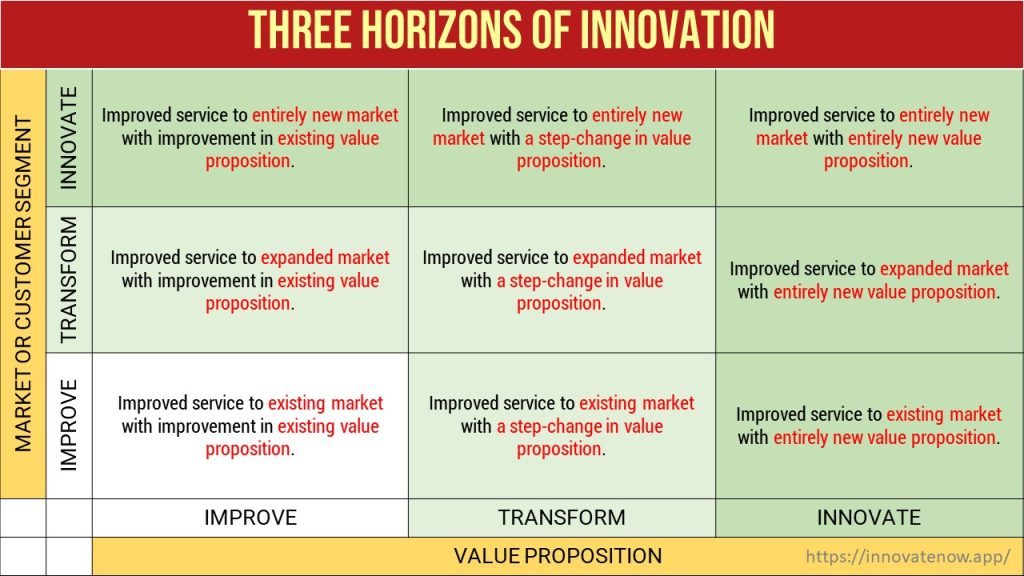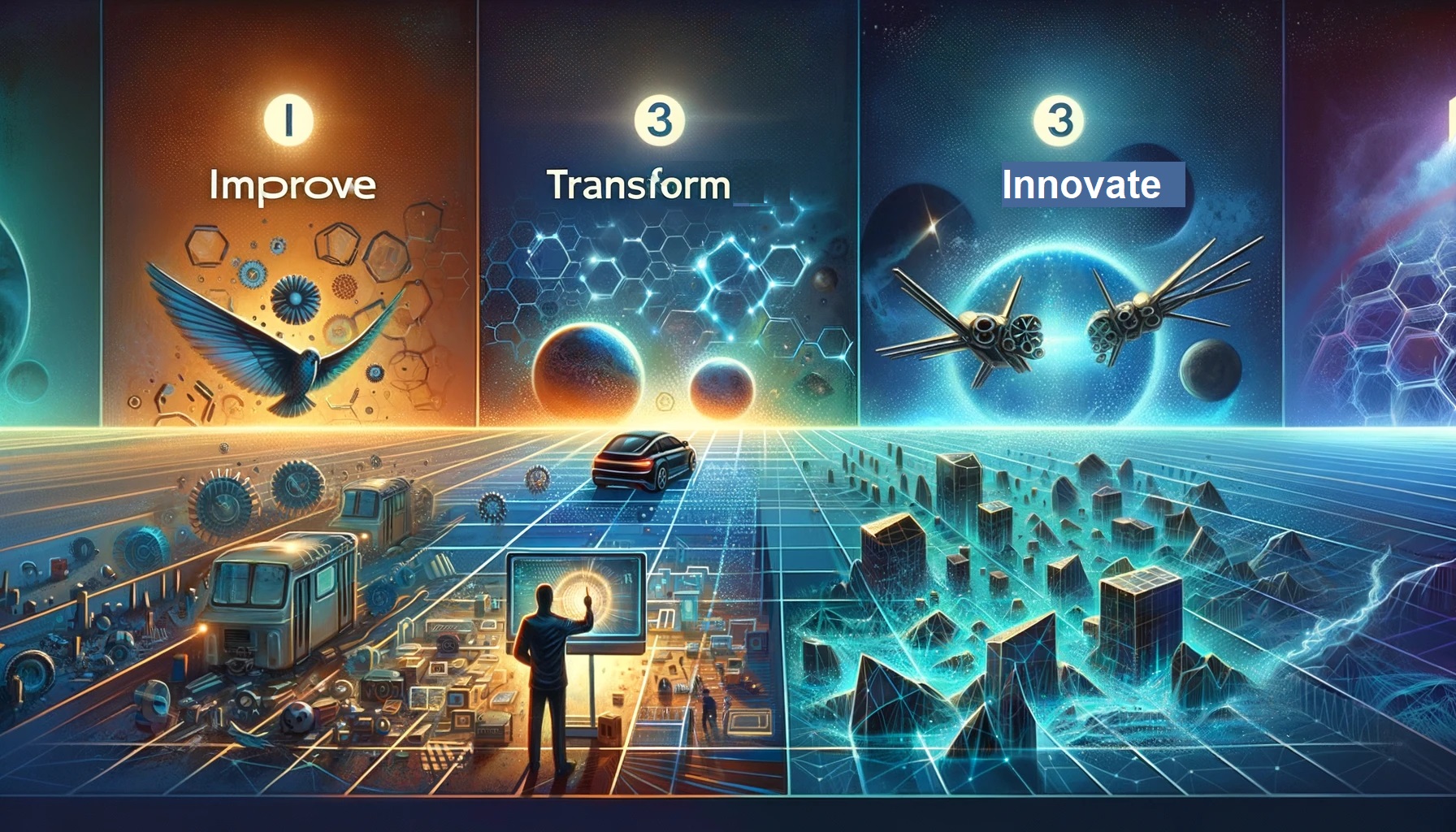Innovation isn’t a one-size-fits-all process. It’s a diverse journey that spans across different scopes and timelines, aptly represented by the Three Horizons of Innovation framework. This powerful tool helps businesses plan for the future while maintaining their current operations. Let’s embark on an explorative journey through each horizon and the nine distinct sections within.

Horizon 1: Improve
Existing Market/Existing Value Proposition:
Here, innovation is about enhancing what you already offer. Think of Coca-Cola adding new flavors to its classic range or Toyota releasing a new car model with advanced features. The key is to improve and update the existing offering to keep your current market engaged.
Another example here could be the incremental improvement of a polyester fabric. By enhancing the material’s breathability and moisture-wicking properties, a textile company can provide existing customers with a higher quality version of a familiar product.
Expanded Market/Existing Value Proposition:
This is where you take your current offerings to new customers. Spotify did this by expanding its streaming services globally without changing its core offering, thus reaching a broader audience without altering its value proposition.
A textiles company might take a well-established product, like organic cotton knitwear, and introduce it to a new market segment, such as eco-conscious activewear consumers, thus expanding its market reach without altering the core value proposition of the product.
Entirely New Market/Existing Value Proposition:
Sometimes, your existing products can fulfill needs in markets you haven’t yet tapped into. For example, GoPro cameras were initially targeted at extreme sports enthusiasts but have since found a market with vloggers and professional filmmakers.
A textile firm could innovate by taking their existing high-performance fabric and introducing it to a completely new industry, such as automotive upholstery, thereby opening up a new market segment.
Horizon 2: Transform
Existing Market/Step-change in Value Proposition:
Here, you significantly upgrade your offering for the same customers. Adobe’s shift from selling physical software to a cloud-based subscription service is a prime example, where they offered a new, more flexible payment and updated model to their existing customer base.
Another example could be the transformation of polyester production to a new bio-engineered process that reduces environmental impact significantly. The market for polyester remains the same, but the value proposition includes the appeal of sustainability.
Expanded Market/Step-change in Value Proposition:
In this section, you’re not just reaching new markets, you’re doing so with a significant upgrade. Netflix’s evolution from a DVD rental service to a global streaming giant shows how a company can transform its value proposition while targeting a wider audience.
A textile company may develop a new fire-resistant fabric and introduce it not only to current markets like workwear but also to new sectors such as interior fabrics for public spaces, which requires stringent fire safety standards.
Entirely New Market/Step-change in Value Proposition:
Innovative companies like Airbnb have done this by not just entering a new market but by changing the rules of the game. They introduced a new way to approach lodging, turning any homeowner into a potential hotelier.
A bold move in this category could be the creation of smart textiles integrated with wearable technology. Such fabrics might monitor health indicators and connect to smartphones, thus creating a new market at the intersection of textiles and technology.
Horizon 3: Innovate
Existing Market/Entirely New Value Proposition:
This is the realm of creating something completely new for the people who already trust you. Apple’s introduction of the iPhone is a historic example, creating a smartphone that offered an unprecedented combination of phone, iPod, and internet communicator.
A textile innovator could introduce a game-changing product such as self-cleaning fabrics to the existing market. This new technology would revolutionize the value proposition for consumers who prioritize convenience and longevity in their fabric choices.
Expanded Market/Entirely New Value Proposition:
Here, you’re breaking ground with something novel and reaching beyond your traditional market. Tesla’s foray into electric vehicles not only introduced a new proposition to car buyers but also appealed to environmentally conscious consumers who were not previously typical car enthusiasts.
Here, one might see the development of bio-fabricated leather alternatives created through fermentation processes, targeting not only traditional leather goods consumers but also vegans and environmentalists.
Entirely New Market/Entirely New Value Proposition:
The pinnacle of innovation is creating something so revolutionary that it carves out its own market. The advent of the internet is the most impactful example, giving rise to digital markets that never existed before.
In this transformative section, the creation of textiles that can harvest and store energy from the human body or the environment could be introduced, creating a new market for energy-positive clothing and accessories.
Conclusions
Navigating the Three Horizons of Innovation requires a delicate balance between managing current successes and investing in future breakthroughs. By understanding and leveraging this framework, businesses can strategically plan for sustained growth and revolutionary change. It’s a roadmap for transformation, guiding organizations to not only survive but thrive in a world of constant evolution.



